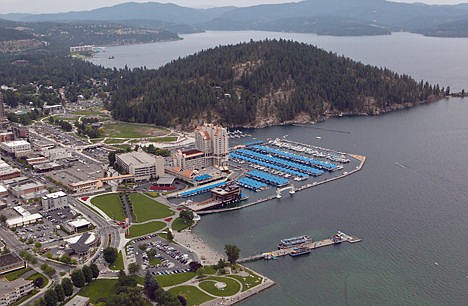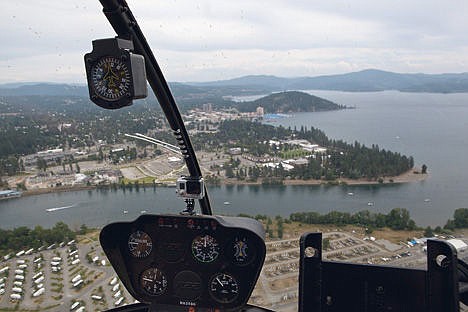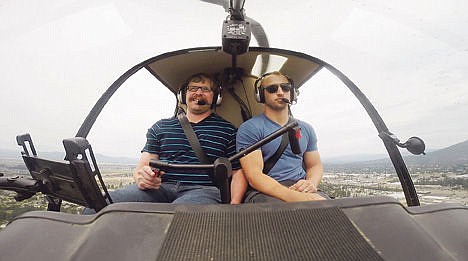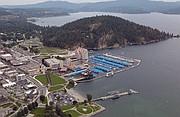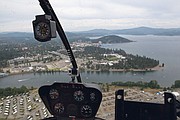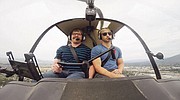Learning to fly
COEUR d'ALENE - I should have been focused on the task of flying the Robinson R22 helicopter toward The Coeur d'Alene Resort.
But at 400 feet above the ground, I couldn't get the tune to David Bowie's "Space Oddity" out of my head.
Prior to the flight, my instructor for the day told me that it was impossible to describe the feeling of flying a helicopter. Hovering closer and closer to The Resort, I was beginning to understand why he wouldn't even attempt a description of the feeling.
It's weightlessness. It's freeing. Like Major Tom in the song, I was floating in a most peculiar way.
A calm quiet feeling took over and I almost forgot that my right hand was controlling the small two-seat helicopter.
"This is all you," Ben Johnson said through his headset.
I looked over to Johnson, a 24-year-old flight instructor with Alpine Aviation, and realized his hand was off the T-shaped controls.
Panic set in and I gripped the controls tightly which, according to Johnson, is one of the biggest mistakes new pilots make.
"A lot of the time I only give them three fingers to use," Johnson said. "So pick your fingers."
The helicopter moved back and forth quickly and Johnson placed his hand back on the control and balanced out what my nervous hand had done. After choosing my three fingers and squaring my shoulders, it was once again "all me" and we continued our flight toward The Resort.
I met with Johnson earlier in the day at Coeur d'Alene Resort Aviation. He was watching golf, the only professional sport he said he can consistently watch, and perhaps sensing my nervousness, he immediately compared flying a helicopter to what was happening on the television.
"Nobody is a good golfer their first time on the course," Johnson said. "You have to learn the shots and the technique first. You have to learn by failing."
I wanted to ask him when the last time a bad shot in golf resulted in a fiery crash, but decided against it.
Talking with Johnson - who said his love for helicopters began as a child when he saw what he described as "the ugliest thing I've ever seen" flying in the air - alleviated some of the nerves that had been building since the day I took the assignment.
After serving in the U.S. Army, Johnson began getting his certifications as a helicopter pilot and pursuing the dream he had since he first saw a helicopter.
"I didn't want to sit behind a desk," Johnson said. "I wanted to fly. I just ran with it."
Johnson eventually hooked up with his former instructor, Kevin Sielaff, and now works with him as an instructor. Alpine Aviation, a year-old business, focuses on one-on-one instruction, something Johnson said is rapidly becoming a thing of the past in aviation.
"They're just ballooning and getting bloated so what might happen is one instructor will fly with 10 different students a week and those students will fly with three different instructors a week," Johnson said. "That's kind of like being in first grade and learning your numbers from three different teachers. When you don't have that consistency it hurts your learning curve. With helicopters, when your learning curve gets pushed back, you end up spending more money."
Johnson said Alpine Aviation caters to individuals who want to pursue both careers in commercial aviation as well as those looking to pursue flying as a hobby.
"If I'm an advocate for anything it's for people to follow their dreams," Johnson said. "I know it sounds very cheesy and cliche but if I can help with that, then I am all the better for it. If I can share my experiences with someone - even for a half-hour share that feeling with them - it's completely worth it for me."
There was a blur of information before we went outside and began the "Discovery Flight." Johnson began by asking me a physics question. I didn't have the heart to tell him how many times it took me to pass college-level physics, so I sat and let him answer for me.
Throughout the 30-minute instruction, Johnson used a toy helicopter to demonstrate different techniques and principles. These principles are what keeps the helicopter moving and in the air. Terms like "mass bumping," "cyclic" and "low-g pushovers" flew at me rapidly.
The knowledge that I would soon be flying a helicopter made it hard to process the information. Before I could even attempt to make sense of it, we were standing next to the R22 and Johnson was going through a pre-flight checklist.
Seeing the helicopter for the first time stretched my nerves even more. The R22, which is commonly used for training pilots, weighs less than 1,000 pounds without passengers and has a range of approximately 240 miles.
Doors are optional, and as I sat in the cockpit to get ready to take off, I felt vulnerable knowing that we were flying in the equivalent of a Jeep Wrangler.
Johnson completed the final checks on the helicopter while the rotors hummed to life. Thankfully, he also gave me one last crash course in what each of the controls and gauges were used for.
Pretty soon we were ascending and Johnson was encouraging me to take the reins.
Floating toward The Resort, Johnson, who prior to working at Alpine Aviation piloted for an aerial photography company, asked me if I wanted to take some photos. Taking my hand off the controls and grabbing my camera eased my nervousness. For a brief moment, while he flew as close as possible to downtown Coeur d'Alene, I relaxed and focused solely on capturing the town from a unique vantage point.
A flurry of photos later, it was once again my turn to fly the helicopter.
Under Johnson's guidance, I began to point the R22 back toward the airport. If I hadn't been hundreds of feet in the air, the scenario would have felt similar to driver's education training.
As we approached the airport, Johnson demonstrated the full capabilities of the small helicopter. Quickly and efficiently, he maneuvered the craft close to the ground and began hovering horizontally back and forth.
After showing off skills earned through hours and hours in the cockpit, Johnson landed the craft and powered it down. When we got out of the helicopter and started walking back to Resort Aviation, he turned to me and asked if I knew why he hesitated to describe what flying feels like and why he was so passionate about it.
All I could do was smile and say, "Absolutely."
"It felt like I was floating in water or something," I told Johnson. "It was such a rush."
Johnson just smiled and said the only word he could use is "freeing."
The half-hour of flight had me hooked on a feeling that you can't really describe. Johnson accomplished his mission of sharing his experiences with me. His dreams led him to the air, and through his passion and expertise it is clear he will help others cultivate their own dreams of flight.
For more information on Alpine Aviation, contact Johnson at (208) 303-0542 or email him at btj.alpineaviationacademy@gmail.com.


